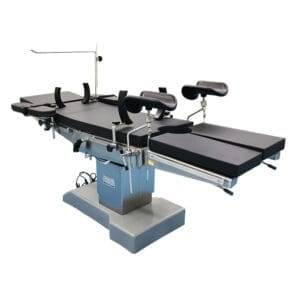عنوان
304 شارع الكاردينال الشمالي
مركز دورتشستر ، ماساتشوستس 02124
ساعات العمل
من الاثنين إلى الجمعة: 7 صباحًا - 7 مساءً
عطلة نهاية الأسبوع: 10 صباحًا - 5 مساءً
عنوان
304 شارع الكاردينال الشمالي
مركز دورتشستر ، ماساتشوستس 02124
ساعات العمل
من الاثنين إلى الجمعة: 7 صباحًا - 7 مساءً
عطلة نهاية الأسبوع: 10 صباحًا - 5 مساءً
In the fast-paced realm of healthcare, technology’s transformative influence is unmistakable. From diagnostics to treatment, technological advancements have not only improved patient outcomes but also redefined the tools and equipment used by medical professionals. Among these tools, operating tables stand out as a prime example of how technology has revolutionized medical practices. This article delves into the intricate ways in which technology has propelled operating table design into a new era of sophistication and efficiency.
 Early Challenges and Basic Designs
Early Challenges and Basic DesignsIn the early days of surgery, operating tables were rudimentary and lacked the ergonomic features essential for precise procedures. Surgeons faced challenges due to fixed positions, limited adjustments, and inadequate patient comfort. These tables hindered the execution of complex surgeries and prolonged procedures.
Enhanced Adjustability through Motorization
With the infusion of technology, operating tables underwent a remarkable transformation. Motorized actuators introduced adjustability that was previously unimaginable. Surgeons can now meticulously adjust table height, tilt angles, lateral tilt, and Trendelenburg positions, enabling optimal patient positioning for diverse procedures. The micro-adjustments offered by these motorized features have elevated the precision and success rates of surgeries.
Radiolucent Materials for Seamless Imaging
The integration of radiolucent materials, another technological advancement, has revolutionized imaging during surgical procedures. Operating tables now boast tabletops that allow X-rays and other imaging modalities to penetrate without hindrance. This innovation eliminates the need to reposition patients during imaging, streamlining the surgical workflow and reducing patient discomfort.
Modern operating tables are designed to accommodate a variety of surgical accessories, ensuring personalized patient support while enhancing surgical efficiency. Attachable armboards, headrests, and leg holders can be effortlessly integrated, catering to the specific requirements of each procedure. This adaptability minimizes the risk of complications arising from nerve compression and facilitates complex surgeries.
Technology has brought forth motorized articulation systems that enable intricate surgical positioning. These systems allow surgeons to rotate and move specific sections of the table with exceptional precision. Such capabilities are invaluable for orthopedic procedures, spinal surgeries, and other interventions where precise alignment is paramount.
Beyond patient considerations, technology has prioritized surgeon comfort and efficiency. Ergonomic designs, inspired by technological innovation, accommodate the surgeon’s posture and movements. These designs help minimize surgeon fatigue during lengthy procedures, allowing them to maintain focus and precision throughout.
Operating tables now integrate pressure management systems and safety features like railings and straps to prevent patient falls. The technology-driven integration of these elements enhances patient safety and comfort during surgery, even in the face of extended procedures.
Infection control is a constant concern in the medical field. Technological advancements have led to the development of operating tables constructed with materials that are easy to clean and disinfect. Some tables are even equipped with antimicrobial coatings that inhibit the growth of harmful microorganisms, reducing the risk of post-operative infections.
Operating tables have embraced technology by incorporating touchscreen controls and remote operation features. Surgeons can now make real-time adjustments without compromising the sterile field. Additionally, these tables can seamlessly connect with other equipment and hospital information systems, facilitating comprehensive patient care.
 AI-Driven Precision and Beyond
AI-Driven Precision and BeyondAs technology continues to surge forward, the future of operating table design holds exciting possibilities. Artificial intelligence (AI) could be harnessed to predict optimal patient positioning based on medical data and procedure requirements. Furthermore, AI-driven robotics might enable even finer adjustments during surgery, enhancing precision and outcomes.
Q1: How have motorized adjustments improved surgical outcomes?
A1: Motorized adjustments allow surgeons to fine-tune patient positioning, optimizing anatomical alignment for different procedures. This level of precision contributes to improved surgical outcomes.
Q2: Are radiolucent tabletops compatible with all imaging modalities?
A2: Yes, radiolucent tabletops are compatible with various imaging modalities, including X-rays and fluoroscopy, as they allow these rays to pass through unhindered.
Q3: Can technology help prevent pressure ulcers during surgery?
A3: Absolutely. Operating tables equipped with pressure management systems redistribute pressure, reducing the risk of pressure ulcers during extended surgeries.
Q4: How does AI integration benefit operating table design?
A4: AI integration holds the potential to predict optimal patient positioning, enhancing surgical precision. Additionally, AI-driven robotics could lead to finer adjustments during surgery for improved outcomes.
Operating table design has undergone a remarkable transformation through the infusion of technology. From enhanced adjustability and imaging capabilities to personalized support and surgeon-friendly features, technological advancements have reshaped the surgical landscape. Patient safety, comfort, and procedural efficiency have all been elevated, cementing the pivotal role of technology in modern healthcare. As we peer into the future, the horizon promises even more innovative leaps, ensuring that operating tables continue to be at the forefront of surgical excellence.